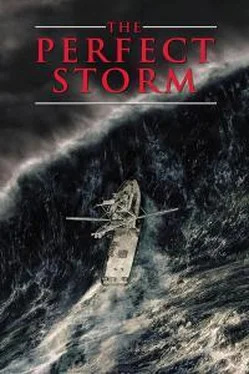Sebastian Junger - The Perfect Storm
Здесь есть возможность читать онлайн «Sebastian Junger - The Perfect Storm» — ознакомительный отрывок электронной книги совершенно бесплатно, а после прочтения отрывка купить полную версию. В некоторых случаях можно слушать аудио, скачать через торрент в формате fb2 и присутствует краткое содержание. Жанр: Триллер, Проза. Описание произведения, (предисловие) а так же отзывы посетителей доступны на портале библиотеки ЛибКат.
- Название:The Perfect Storm
- Автор:
- Жанр:
- Год:неизвестен
- ISBN:нет данных
- Рейтинг книги:3 / 5. Голосов: 1
-
Избранное:Добавить в избранное
- Отзывы:
-
Ваша оценка:
- 60
- 1
- 2
- 3
- 4
- 5
The Perfect Storm: краткое содержание, описание и аннотация
Предлагаем к чтению аннотацию, описание, краткое содержание или предисловие (зависит от того, что написал сам автор книги «The Perfect Storm»). Если вы не нашли необходимую информацию о книге — напишите в комментариях, мы постараемся отыскать её.
The Perfect Storm — читать онлайн ознакомительный отрывок
Ниже представлен текст книги, разбитый по страницам. Система сохранения места последней прочитанной страницы, позволяет с удобством читать онлайн бесплатно книгу «The Perfect Storm», без необходимости каждый раз заново искать на чём Вы остановились. Поставьте закладку, и сможете в любой момент перейти на страницу, на которой закончили чтение.
Интервал:
Закладка:
Bylander, grateful for something to do, sorts through the wreckage on the floor and stuffs tins of food, bottled water, clothes, and a wire cheese sheer into a sea bag. Sue, we don't need the sheer, we can bite the cheese! Stimpson says, but Bylander just shakes her head. I've read about this and it's the little niceties that make the difference! Ray, where are the boat cushions? While preparing their emergency bag, they get knocked over a second time. This one is even more violent than the first, and the boat is a long time in coming back up. Stimpson and Leonard pick themselves off the floor, bruised and dazed, and Bylander sticks her head out the hatch to check for damage on deck. My God, Karen! she screams. The life raft's gone!
"I was in a corner and I covered myself with soft things," says Stimpson, "and with a flashlight I took about ten minutes and wrote some goodbyes and stuck it in a Ziplock bag and put it in my clothing. That was the lowest point. We had no contact with anyone, it was the dark of the night—which brings its own kind of terror—and I had a sense that things were going to get worse. But it's a strange thing. There was no sentiment there, no time for fear. To me, fear is two AM, walking down a city street and someone's following me—that to me is a terror beyond words. What was happening was not a terror beyond words. It was a grim sense of reality, a scrambling to figure out what to do next, a determination to stay alive and keep other people alive, and an awareness of the dark noisy slamming of the boat. But it wasn't a terror beyond words. I just had an overwhelming sense of knowing we weren't going to make it."
Stimpson doesn't know it, but Bylander tapes her passport to her stomach so her body can be identified. Both women, at this point, are prepared to die. After Stimpson finishes writing her goodbyes, she tells Leonard that it's time to issue a mayday. Mayday comes from the French venez m'aider— come help me!—and essentially means that those on board have given up all hope. It's up to someone else to save them. Leonard is motionless on his berth. Okay, he says. Stimpson forces her way out to the cockpit and Bylander sits down at the nav table to see if she can coax the VHF back to life.
At 11:15 PM, October 29th, a freighter off Long Island picks up a woman's terrified voice on the VHF: This is the Satori, the Satori, 39:49 north and 69:52 west, we are three people, this is a mayday. If anyone can hear us, please pass our position on to the Coast Guard. Repeat, this is a mayday, if anyone can hear us, pass our position on to the Coast Guard. . .
The freighter, the Gold Bond Conveyor, relays the message to Coast Guard operations in Boston, which in turn contacts the Coast Guard cutter Tamaroa in Provincetown Harbor. The Tamaroa has just come off Georges Bank, where she was conducting spot checks on the fishing fleet, and now she's waiting out the weather inside Cape Cod's huge flexed arm. A small Falcon jet scrambles from Air Station Cape Cod and the Tamaroa, 1,600 tons and 205 feet, weighs anchor at midnight and heads down the throat of the storm.
The crew of the Satori have no way of knowing whether the radio is working, they just have to keep repeating the mayday and hope for the best. And even if the radio is working, they still have to be within two or three miles of another vessel for the signal to be heard. That's a lot to ask for on a night like this. Bylander, wedged behind the nav table, broadcasts their name and position intermittently for half an hour without any response at all; they're alone out there, as far as she can tell. She keeps trying—what else is there to do?—and Stimpson goes back on deck to try to keep the Satori pointed into the seas. She's not there long when she hears the sound of an airplane fading in and out through the roar of the storm. She looks around frantically in the darkness, and a minute later a Falcon jet, flying low under the cloud cover, shrieks overhead and raises Bylander on the VHF. "Sue was so excited she was giddy,” Stimpson says, "but I wasn't. I remember not feeling elated or relieved so much as like, instantly, I'd rejoined the world of the living."
The Falcon pilot circles just below cloud level and discusses what to do next over the VHF with Bylander. The Tamaroa won't be there for another twelve hours, and they've got to keep the boat afloat until then, even if that means burning out the engine. They can't afford to risk any more knockdowns. Bylander, against Leonard's wishes, finally toggles the starter switch, and to her amazement it turns over. With the storm jib up and the prop turning away they can now get a few degrees to the weather. It's not a lot, but it's enough to keep from getting broached by the seas.
Throughout the night the Falcon pilot flies over them, reassuring Bylander that they're going to come out of this alive. Stimpson stays at the helm and Leonard lies on his bunk contemplating the impending loss of his boat. When the Tamaroa arrives he'll have to abandon ship, which is an almost unthinkable act for a captain. The Satori is his home, his life, and if he allows himself to be taken off by the Coast Guard he'll probably never see her again. Not intact, anyway. At some point that night, lying on his bunk waiting for dawn, Ray Leonard decides he won't get off the boat. The women can leave if they want to, but he'll see the vessel into port.
Throughout that night the Tamaroa slugs her way through the storm. She's a bulldog of a vessel, built to salvage crippled battleships in World War Two, and she can "tow anything afloat," according to her literature. The sea state is so high, though, that the most she can make is three or four knots— roughly walking pace. On the larger swells she plunges into the crest, stalls, and launches out the far side, spray streaming off her bridge and greenwater sheeting out her scuppers. She crosses Cape Cod Bay, threads the canal, leaves the Elizabeth Islands to port, and finally turns the corner around Martha's Vineyard. Commander Lawrence Brudnicki, chief officer on board, estimates that they'll arrive on-scene late the next afternoon; the Satori crew has to stay afloat until then. They have no life raft or survival suits on board, and the nearest helicopter base is an hour away. If the Satori goes down, the crew is dead.
Brudnicki can't speak directly to the Satori, but he can relay messages via the Falcon that's circling above them. Both ship and plane are also in contact with the First District Command Center in Boston—Di Comcen, as it's referred to in Coast Guard reports. Di Comcen is responsible for coordinating all the Coast Guard vessels and aircraft on the rescue, and developing the safest strategy for taking the people off the boat. Every decision has to be approved by them. Since the Satori isn't sinking yet, they decide to have the Falcon fly cover until the Tamaroa arrives, and then take the crew off by raft. Air rescue in such conditions can be riskier than actually staying with the boat, so it's used as a last resort. As soon as day breaks, the Falcon will be relieved by an H-3 rescue helicopter, and H-3S will fly cover in shifts until the Tamaroa shows up. Helicopters have a limited amount of flying time—generally about four hours—but they can pluck people out of the water if need be. Falcon jets can't do much for people in the water except circle them and watch them drown.
From the incident log, Di Comcen: 2:30 AM—slv [sailing vessel] is running out of fuel, recommend we try to keep Falcon o/s [on-scene] until Tamaroa arrives. 5:29 AM—Falcon has lost comms [communication] with vessel, vessel is low on battery power and taking on water. Pumps are keeping up but are run by ele [electric].
7:07 AM—Falcon ols, vessel has been located. Six hours fuel left. People on board are scared.
The H-3 arrives on scene around 6:30 and spends half an hour just trying to locate the Satori. The conditions are so bad that she's vanished from the Falcon's radar, and the H-3 pilot is almost on top of her before spotting her in the foam-streaked seas. The Falcon circles off to the southwest to prepare a life-raft drop while the H-3 takes up a hover directly over the boat. In these conditions the Falcon pilot could never line up on something as small as a sailboat, so the H-3 acts as a standin. The Falcon comes back at 140 knots, radar locked onto the helicopter, and at the last moment the H-3 falls away and the jet makes the drop. The pilot comes screaming over the Satori's mast and the copilot pushes two life-raft packages out a hatch in the floorboards. The rafts are linked by a long nylon tether, and as they fall they cartwheel apart, splashing down well to either side of the Satori. The tether, released at two hundred feet into a hurricane-force wind, drops right into Bylander's hand.
Читать дальшеИнтервал:
Закладка:
Похожие книги на «The Perfect Storm»
Представляем Вашему вниманию похожие книги на «The Perfect Storm» списком для выбора. Мы отобрали схожую по названию и смыслу литературу в надежде предоставить читателям больше вариантов отыскать новые, интересные, ещё непрочитанные произведения.
Обсуждение, отзывы о книге «The Perfect Storm» и просто собственные мнения читателей. Оставьте ваши комментарии, напишите, что Вы думаете о произведении, его смысле или главных героях. Укажите что конкретно понравилось, а что нет, и почему Вы так считаете.












